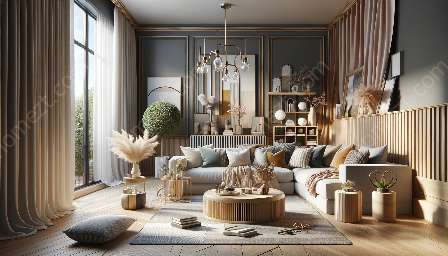Colors play a significant role in influencing human psychology. When it comes to homemaking and interior decor, understanding the psychological impact of colors can help create harmonious and inviting spaces. Below, we'll explore the psychology of different colors and how it relates to color schemes and palettes.
The Psychology of Different Colors
Color psychology studies the effects of different colors on human behavior and emotions. Various colors evoke specific psychological responses, and understanding these can be beneficial when choosing color schemes for interior decor.
Red
Red is associated with energy, passion, and love. It can stimulate and raise the pulse rate, making it an excellent choice for creating a dynamic and intimate atmosphere in certain areas of the home, such as the dining room or living room.
Blue
Blue is known for its calming and soothing effects. It promotes relaxation and tranquility, making it an ideal choice for bedrooms and spaces intended for unwinding and rest.
Yellow
Yellow is associated with happiness and optimism. It can bring warmth and energy to a room, making it a suitable choice for kitchens and living spaces. However, excessive use of yellow can lead to feelings of agitation, so it's essential to use it in moderation.
Green
Green represents nature and balance. It has a calming and rejuvenating effect, perfect for creating a sense of harmony and well-being in interior spaces. Green can be used in various rooms, especially those intended for relaxation, such as bedrooms and living rooms.
Purple
Purple symbolizes luxury and creativity. It can add a touch of sophistication to a room and stimulate creativity. Use purple sparingly to avoid overwhelming the space, as it can be overpowering in large amounts.
Orange
Orange evokes feelings of enthusiasm, warmth, and excitement. It can be used to add energy and vitality to a space, making it suitable for areas where socialization and interaction are encouraged, such as the dining area or entertainment room.
White
White represents purity and simplicity. It creates a sense of spaciousness and cleanliness, making it a popular choice for various interior spaces, particularly smaller rooms where the goal is to maximize the sense of openness and brightness.
Black
Black is associated with sophistication and power. It can add a sense of mystery and elegance to a room. However, extensive use of black can make a space feel closed-in and oppressive, so it's crucial to balance it with lighter colors.
Color Schemes and Palettes
Understanding the psychology of different colors is essential when creating color schemes and palettes for interior decor. By combining colors strategically, you can evoke specific emotions and moods within a space.
Monochromatic Schemes
Monochromatic color schemes utilize variations of a single color, creating a harmonious and cohesive look. They can evoke a sense of serenity and simplicity, making them suitable for minimalist and contemporary interior designs.
Analogous Schemes
Analogous color schemes use colors that are adjacent to each other on the color wheel. They create a cohesive and harmonious feel while offering more variety than monochromatic schemes. Analogous schemes are a great choice for creating a unified and visually appealing space.
Complementary Schemes
Complementary color schemes utilize colors that are opposite each other on the color wheel. They create a dynamic and vibrant look, making them suitable for spaces where energy and contrast are desired. When utilizing complementary schemes, it's important to balance the colors to avoid overwhelming the senses.
Triadic Schemes
Triadic color schemes use three colors that are evenly spaced around the color wheel. They offer a balanced and lively appeal, making them an excellent choice for creating visually stimulating interiors. When implementing a triadic scheme, it's essential to maintain a balance among the colors to prevent the space from feeling chaotic.
Homemaking and Interior Decor
When it comes to homemaking and interior decor, the psychology of different colors plays a crucial role. Understanding how colors influence emotions and behavior can guide homeowners in creating spaces that are not only aesthetically pleasing but also conducive to the desired atmosphere and lifestyle.
Personalizing Spaces
By incorporating knowledge of color psychology, individuals can personalize their living spaces to reflect their personalities and preferences. For instance, introverts may prefer calming and soothing colors in their private spaces, while extroverts may opt for vibrant and energizing colors in areas meant for socializing.
Creating Ambiance
Color choices can significantly impact the ambiance of a room. Warm colors such as red, orange, and yellow can create a cozy and lively atmosphere, while cool colors like blue and green can induce a sense of tranquility and relaxation. By selecting appropriate colors, homeowners can tailor the ambiance of each room to suit its intended purpose.
Enhancing Functionality
Colors can also be used to enhance the functionality of different spaces within a home. For example, using energizing colors in a home office can foster productivity and creativity, while using soothing colors in the bedroom can promote a restful and rejuvenating environment.
Facilitating Flow
Color schemes and palettes can be employed to create a seamless flow between interconnected spaces. By using cohesive colors and palettes throughout the home, a sense of continuity and harmony can be achieved, contributing to overall visual appeal and comfort.
Reflecting Trends and Styles
Understanding the psychological impact of colors also enables homeowners to stay abreast of current trends and styles in interior decor. By incorporating popular colors and palettes, individuals can ensure that their living spaces remain relevant and visually appealing.
Conclusion
Color psychology is a valuable tool in the realm of homemaking and interior decor. By understanding the psychological effects of different colors and their relation to color schemes and palettes, individuals can create inviting and harmonious living spaces that cater to their emotional and psychological needs. The strategic use of colors can contribute to a more enjoyable and aesthetically pleasing home environment, enriching the overall living experience.


